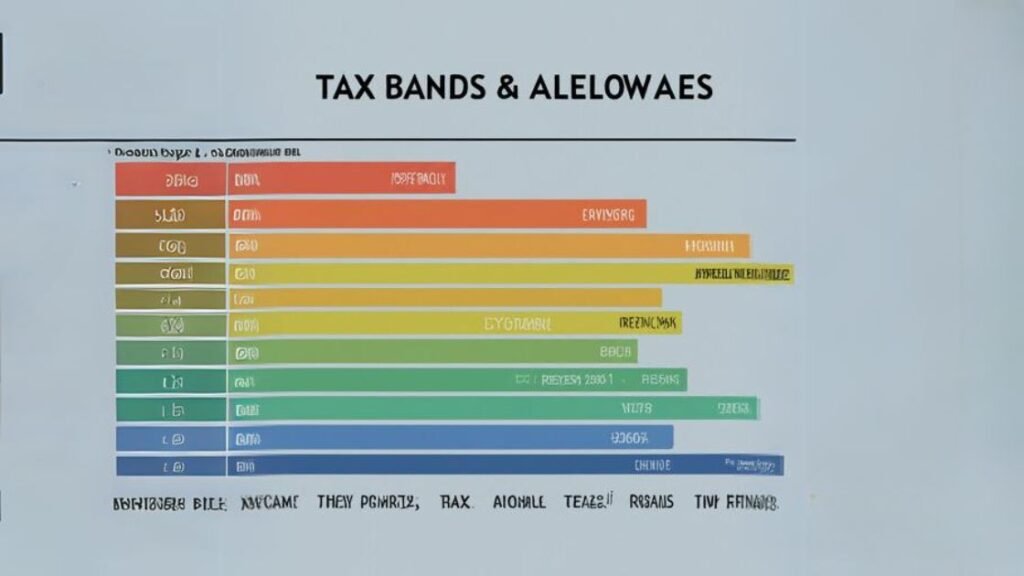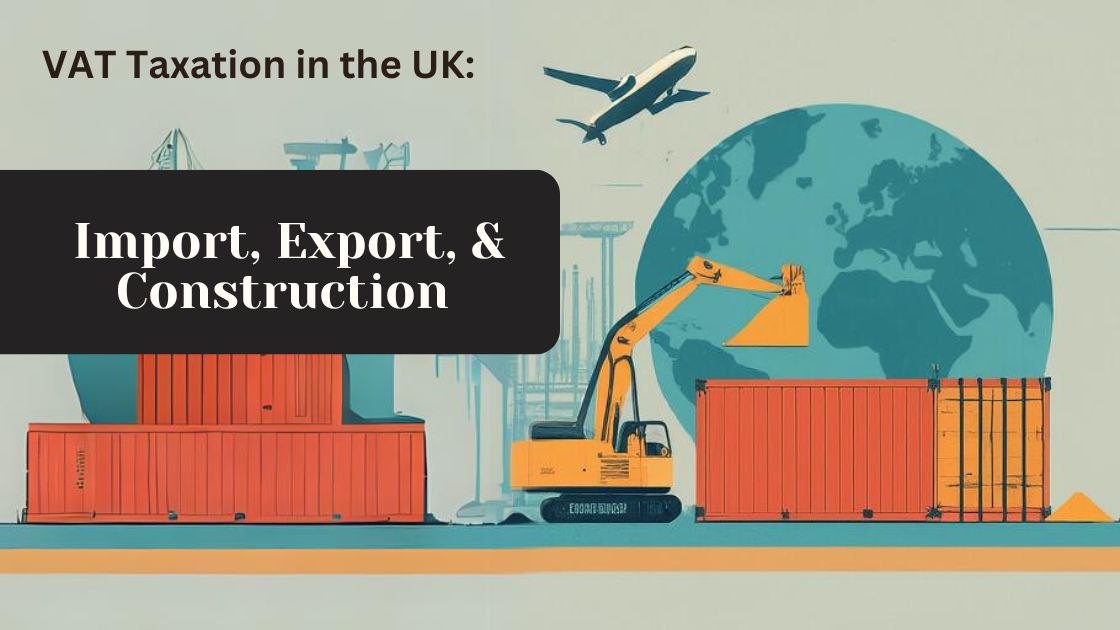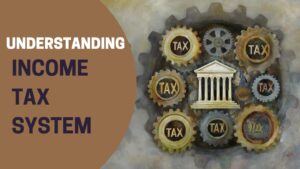Income tax is a fundamental aspect of the UK’s tax system, impacting both individuals and businesses. Read through this post to enhance your understanding on income tax bands, allowances, rates, and how to calculate income tax liability for individuals and businesses.
Let’s delve into the intricacies of tax bands and explore the various tax types that shape the UK’s fiscal landscape. These rates are as for the year 2024-2025.
- Income Tax: Income Tax is the tax on income earned by individuals, including wages, salaries, pensions, and rental income. It is calculated based on taxable income and is subject to different tax bands and rates. Income tax is applied on individual’s earnings above certain threshold. The tax band based on individual’s income is:
| # | Main Rates | Income Tax Rate | Income tax band | Note |
| 1 | Personal Allowance | 0% | Upto £12,570 | Tax-free income. One can increase allowed personal allowance by claiming Marriage or Blind person allowances (if eligible). |
| 2 | Basic Rate | 20% | £12,570 to £50,270 | |
| 3 | Higher Rate | 40% | £50,270 to £125,140 | Allowed Personal allowance decrases, if taxable income over £100,000 |
| 4 | Additional Rate | 45% | Above £125,140 | Allowed Personal allowance is zero, if taxable income over £125,140 |
- National Insurance Contributions (NICs): NICs are contributions paid by individuals and employers to fund state benefits, including the state pension and healthcare. NICs are based on earnings and are collected alongside income tax. There are 4 main types of classes in NICs.
| # | Classes | Sub-class | Description | NIC Rate |
| 1 | Class 1 | Primary Class 1 | Contribution made by employees based on their earnings. |
|
| Secondary Class 1 | Contributions made by employers based on their employees’ earnings. |
|
||
| 2 | Class 2 | Contributions paid by self-employed individuals who earn above a certain threshold. |
|
|
| 3 | Class 3 | Voluntary contributions paid by individuals to fill gaps in their National Insurance record, such as when they are not working or earning below the threshold for paying NICs. | ||
| 4 | Class 4 | Contributions paid by self-employed individuals based on their profits. |
|
Read through the post to gain more insight on how to register for NIC and NIC category letters.
- Value Added Tax (VAT): VAT is a consumption tax levied on the sale of goods and services. There are three main VAT rates:
| # | Rates | % of VAT Rate | Rate Applies to |
| 1 | Standard Rate | 20% | Most goods and services, including electronics, clothing, furniture, and professional services like consulting and accounting. |
| 2 | Reduced Rate | 5% | Certain essentials such as children’s car seats, domestic fuel and power, and renovations to residential properties. |
| 3 | Zero Rate | 0% | Most food and drink (excluding alcohol and certain luxury items), books and newspapers, certain financial and insurance services, public transport fares, and prescription medications. |
Note: Businesses that are registered for VAT must charge the appropriate rate of VAT on their sales, collect VAT from their customers, and pay this VAT to HM Revenue & Customs (HMRC) through regular VAT returns. Conversely, businesses can reclaim VAT on their purchases and expenses, reducing their overall VAT liability.
Read through this post to understand who and under what circumstances one should file VAT tax.
- Corporation Tax: Corporation tax is imposed on the profits of UK-resident companies and non-UK companies with a permanent establishment in the UK.
| # | Rates | Tax Rate | Who will fall under this category? |
| 1 | Small Profit Rates | 19% | Companies with profits under £50,000. |
| 2 | Main Rate | 25% | Companies with profits over £250,000. |
| 3 | Marginal Relief | Pay tax at Main rate, reduced by a marginal relief. | Companies with profits between £50,000 and £250,000. |
Different cooperation tax rate is applied to companies that make profits from oil extractions or oil rights in the UK, these are called ring fence companies. Learn more on this.
Read through the post to learn more about the marginal relief and who can claim it.
Companies can deduct certain capital expenditures, known as capital allowances, from their taxable profits before calculating corporation tax. Capital allowances may include expenses for machinery, equipment, vehicles, and certain types of building renovations.
Loss Relief: Companies can carry forward losses from previous years to offset against future profits, reducing their corporation tax liability. Loss relief can help companies manage their tax liabilities during periods of financial difficulty.
- Capital Gains Tax (CGT): CGT is imposed on the profit earned from the sale of assets, such as property, stocks, and other investments. Individuals are required to report capital gains and pay tax on the gain above the annual exempt amount. Capital gains above the annual exempt amount (£3,000) are subject to CGT at various rates depending on the individual’s income tax band.
- 10% for basic rate taxpayers.
- 20% for most assets for individuals at higher rate and additional rate taxpayers.
- 28% for residential property and carried interest (profits from certain types of investment funds) for individuals at higher rate and additional rate taxpayers.
- Additional rate taxpayers, those with taxable income above the additional rate threshold, may pay capital gains tax at the higher rate of 28% for most assets and 36% for residential property and carried interest.
Read the post to gain insight on CGT reliefs and taxable amount calculations.
- Inheritance Tax (IHT): Inheritance tax is levied on the value of an individual’s estate upon their death.
| # | Rates | Threshold value | Tax Rate | Who will fall under this category? |
| 1 | Nil Rate Band | £325,000 | 0% | No tax if value of estate asset is below the threshold or
If you leave everything above the threshold to your spouse, civil partner, a charity, or a community amateur sports club |
| 2 | Residence Nil Rate Band | £500,000 | 0% | If you leave your main residence to the direct descendants (e.g., children or grandchildren), then no tax below the threshold value. |
| 3 | Inheritance Tax Rate | 40% | Applicable on the value of the taxable estate above the eligible threshold. | |
| 36% | If you leave 10% or more of the ‘net value’ to charity in your will. |
- Taxable Estate Calculation: The taxable estate is calculated by adding up the value of all assets owned by the deceased, including property, investments, savings, and personal possessions. Any liabilities, debts, funeral expenses, and certain exemptions or reliefs can be deducted from the total value of the estate to arrive at the taxable estate.
However, certain gifts made during the deceased’s lifetime may be subject to lower rates or exemptions, depending on when the gifts were made and to whom they were given. Learn more about exemptions you could apply for inherited estates.
- Council Tax: Council tax is a local tax collected by local authorities to fund services such as schools, waste collection, and policing. Council Tax bands are labelled from A to H (and sometimes I or J in Wales), with B and A representing properties with the lowest value and H representing properties with the highest value. Each band corresponds to a specific range of property values.
- Certain properties may be eligible for discounts or exemptions from Council Tax. For example, single occupants may be entitled to a 25% discount on their Council Tax bill. Other exemptions may apply to properties occupied by full-time students, certain disabled persons, or properties that are unoccupied and undergoing major repairs.
- Council Tax Support: Low-income households may be eligible for Council Tax Support, which provides financial assistance to help with Council Tax payments.
Explore through the post to understand more about various exemptions you could look for Council tax.
- Stamp Duty Land Tax (SDLT): SDLT is payable on the purchase of land and property in England and Northern Ireland above certain thresholds.
| # | Rates | Rate Band | Tax Rate | Who will fall under this category? |
| 1 | Standard Residential Property Rates | Zero-Rate Band | 0% | No tax if value of property price is below £250,000. |
| Higher Rate Band | 5% | Portion of the property price above £250,000 and up to £925,000 | ||
| Additional Rate Band | 10% | Portion of the property price above £925,000 and up to £1.5 million | ||
| 12% | Portion of the property price above £1.5 million | |||
| First-Time Buyer Relief |
|
|||
| 2 | Additional Property Rate | 3% higher than the standard rates for each band. | Purchases of additional residential properties, such as second homes and buy-to-let properties. | |
| 3 | Commercial Property Rates | Rates vary depending on the purchase price and the nature of the property. |
There are various exceptions, reliefs, and exemptions available for certain types of property transactions, such as transfers between spouses or civil partners, purchases of agricultural land, and transactions involving charities or public bodies. Read through the post to learn more on the same.
Individuals or businesses can apply for tax credits and reliefs. Read through the post to learn more about the various options available under tax credits and reliefs.






